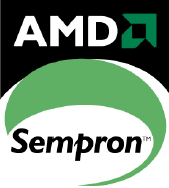AMD's Sempron 3300+: 90nm Budget Computing
by Anand Lal Shimpi on April 18, 2005 2:10 AM EST- Posted in
- CPUs
When AMD offered to send us their latest Sempron CPU for review, we honestly felt a little ashamed - we had almost entirely forgotten about the budget CPU that launched last June. Had we missed other Sempron reviews since its launch? Were we too tied up in the higher end desktop processors and the dual core migration to pay attention to AMD's brand new budget line? After a moment's panic, we calmed ourselves and realized something that had surprised us a bit - AMD hadn't released a faster Socket-754 Sempron since its launch in June 2004. Not a single new CPU in ten and a half months. We stopped feeling so bad.

Intel was slightly better, but not by much. After our original review of the 90nm Celeron D, Intel released one more CPU, the Celeron D 345, late last year, but it's been quiet since then. And we thought the mainstream CPU race had slowed down.
So, it was time for an updated comparison, but luckily, the field hadn't changed much - or had it? Remembering back to our original Sempron review, AMD initially introduced two Semprons: a Socket-A and an Socket-754 version. The Socket-A version has topped out at 3000+ (2.0GHz) and it doesn't look like there's any future beyond it for the aging platform. The Socket-754 platform has yet to out-live its welcome and thus, AMD's newest Sempron, the Sempron 3300+, is a Socket-754-only CPU. The Socket-754 Sempron is based on AMD's K8 architecture, but is a 32-bit only CPU (no x64 support here). As a Socket-754 CPU, the Sempron only features a single channel DDR400 memory controller.
Intel's Celeron D 345 was merely a clock bump to the Celeron D 335 that we reviewed last June, bringing Intel's fastest Celeron up to 3.06GHz while still remaining on the 533MHz FSB. AMD's Sempron 3300+ isn't as simple of a transition, however. The original Socket-754 Sempron was built on a 130nm process and featured a 256KB L2 cache, whereas the new Sempron 3300+ is built on AMD's 90nm process and features a 128KB L2 cache. The new Sempron also features all of the enhancements that made it into the 90nm Athlon 64 processors - mainly SSE3 support and some enhancements to the memory controller.
The higher rating is due to a higher clock speed; the Sempron 3300+ runs at 2.0GHz compared to the 3100+'s 1.8GHz clock. But with half of the L2 cache, the performance picture is bound to be much more interesting than just a regular clock bump.
With only a 128KB L2 cache, the Sempron 3300+ is definitely a step back in terms of the cache sizes that we expect to see on modern day microprocessors. At the same time, halving the cache while moving to a smaller process ensures that AMD can enjoy larger profit margins on these new Sempron CPUs. But AMD's profit margins aren't our concern here; what we care about is how the 3300+ performs and going one step further, a cool running 90nm chip with a very small 128KB L2 cache is quite attractive to the overclocker in us.
With an on-die memory controller, the Socket-754 Semprons can get away with having relatively small L2 caches, since their main memory access latencies are very low to begin with. But even if we estimate that the on-die memory controller of a Sempron reduces memory accesses to around ~120 cycles, an access from L2 cache is going to still take about 1/10th that. In the end, while AMD's K8 architecture is less dependent on large caches, it is still not impervious to the impact that a small one can have.
Priced at $127, the Sempron 3300+ is priced similarly to Intel's Celeron D 345 ($133) and the Athlon 64 3000+ ($140). That being said, let's see how it competes...
The Test
AMD Athlon 64 Configuration
Socket-939 Athlon 64 CPUs
2 x 512MB OCZ PC3200 EL Dual Channel DIMMs 2-2-2-10
MSI nForce4 SLI Motherboard
ATI Radeon X800 XT PCI Express
AMD Sempron Configuration
Socket-754 Sempron CPUs
2 x 512MB OCZ PC3200 EL Dual Channel DIMMs 2-2-2-10
ABIT NF8 nForce3 Motherboard
ATI Radeon X800 XT AGP
Intel Celeron D Configuration
LGA-775 Intel Celeron D 345 (3.06GHz)
2 x 512MB Crucial DDR-II 533 Dual Channel DIMMs 3-3-3-12
Intel 915P Motherboard
ATI Radeon X800 XT PCI Express










53 Comments
View All Comments
xsilver - Monday, April 18, 2005 - link
#2 cool'n'quiet is enabled I think, no 64bit instructions, thats all....nice article.... boring cpu :P maybe a s939 version may help things?
Calin - Monday, April 18, 2005 - link
I would still prefer the Athlon 64 on Socket 939. However, this new Sempron would be good for some kind of HTPC/media computer. How about the power envelope? Cool and Quiet?snedzad - Monday, April 18, 2005 - link
Great article as always.---
Greetings from Bosnia.